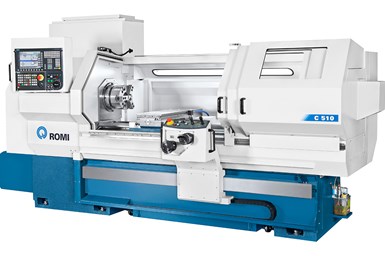Romi's C Series Lathes Offer Flexibility
Romi’s C 420 CNC lathe features a distance between centers of 39" (1 m), while the C 510 has 59" (1.5 m) between centers, giving manufacturers flexibility in the length of the work they can machine.
Share






Romi’s line of CNC lathes are designed for flexibility and can be used for numerous specialty applications. The C 420 and C 510 lathes specifically, are suited for manufacturers that machine gun barrels.
The C 420 features a distance between centers of 39" (1 m), while the C 510 has 59" (1.5 m) between centers. This gives manufacturers flexibility in the length of the work they can machine, which is critical to gun barrel manufacturing.
Both models are equipped with a Siemens Sinumerik 828D CNC control, which features a 10.4" LCD monitor and resources for creating and editing programs. It is suited for shops that deal with variety of sizes and customization, which is inherent to gun barrel manufacturing. Other features that make the control an ideal choice for this application include canned cycles for turning and drilling, linear and circular interpolation functions, thread opening functions, reference functions, coordinate systems, 256 pairs of tool wear offsets, a tool life cycle manager, background editing, and simulation of 2D and 3D machining.
Each C Series lathe is also equipped with the Romi Manual Machining Package that allows users to complete simple operations manually without programming.
Pneumatic and hydraulic tailstocks are available, enhancing flexibility and versatility. Users can also implement customized or specialty workholding devices and steady rests. The machines were built based on an open design, so that shops can customize many features as needed.
In addition to flexibility in setup, Romi machines are said to exhibit rigidity. All key components of Romi C 420 and C 510 Series lathes, including the robust monobloc bed, are designed and built in house for control and quality assurance. The beds feature a robust structure supported by cast-iron columns and are internally ribbed to absorb vibrations during machining.
Related Content
-
Quick-Change Tool Heads Reduce Setup on Swiss-Type Turning Centers
This new quick-change tooling system enables shops to get more production from their Swiss turning centers through reduced tool setup time and matches the performance of a solid tool.
-
Industry Analysis: Machining Semiconductor Components
With many machine shops anticipating long-term growth in demand from the semiconductor industry, it is worth the time to heed the advice of manufacturers who have already been servicing this end-market for years.
-
Top Shops: Designing a Shop to Meet Customer Needs
Working closely with customers and making careful investments has enabled this Wisconsin machine shop to tackle difficult jobs with tight deadlines as a core part of its business.
























